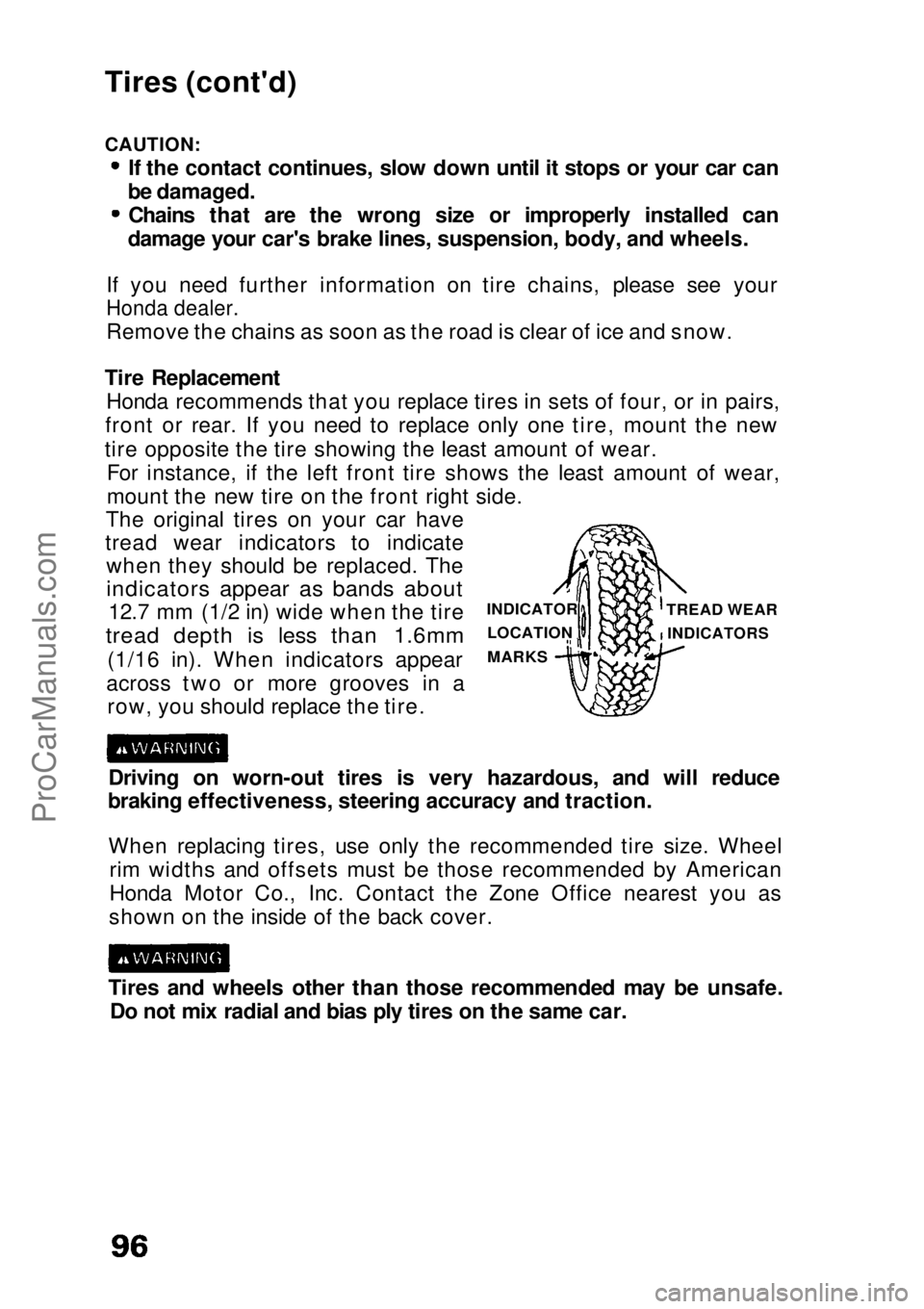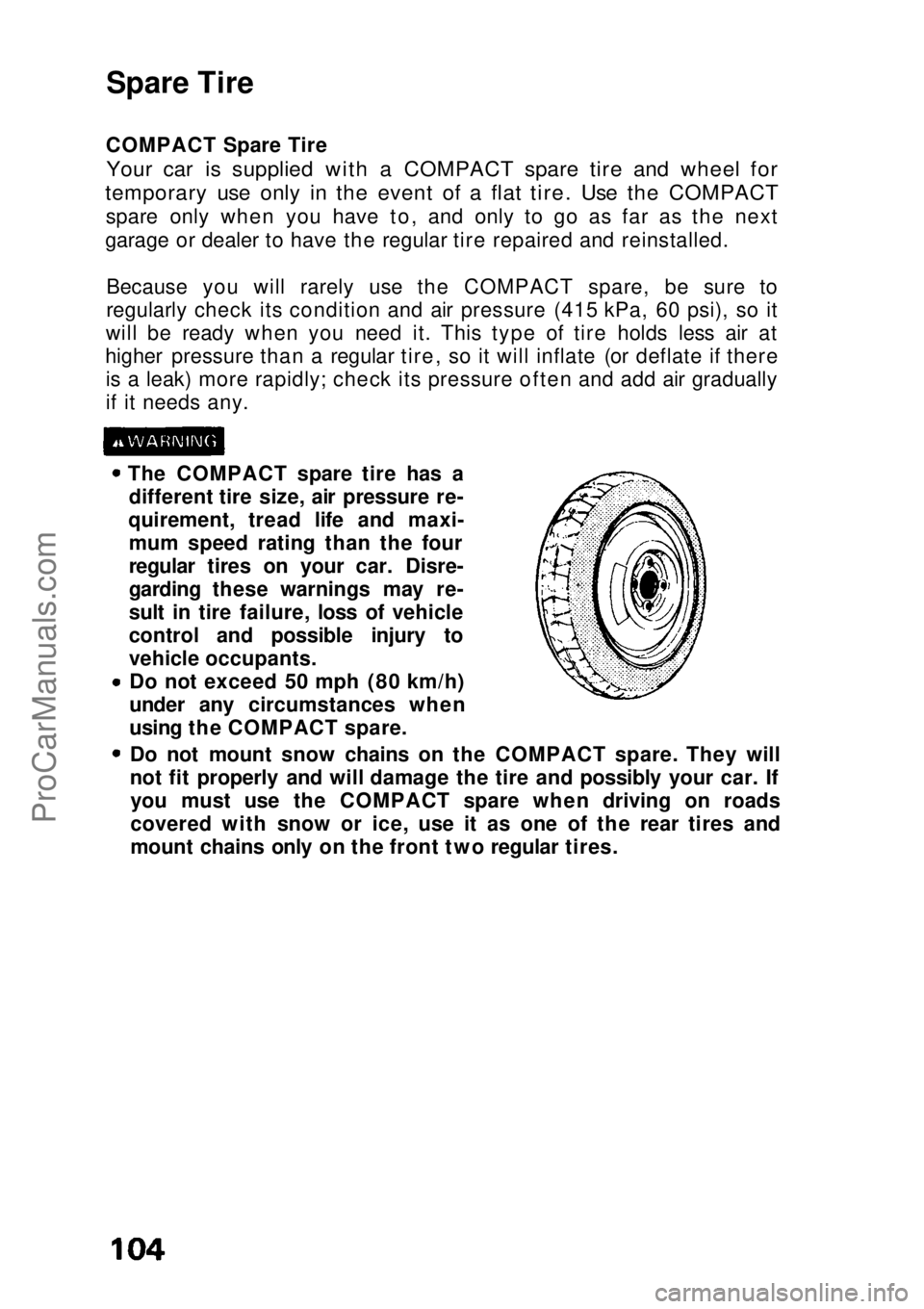Page 94 of 136

The factory installed tires on your car were selected to match the
car's performance capabilities and to provide the best combination
of handling, ride comfort and tread wear.
We recommend that you get the same size, type, and grade of tires when replacement is necessary. If your tires have an all-season
tread design, the model name will be followed by the marking: "M + S" (mud and snow) or "all-season".
If you decide not to get the same brand of tires as those originally
installed, you should make sure that the replacements are the radial
type, of the same size, load range and speed rating as the original
tires.
If you have any questions about your car's tires, please contact
your Honda dealer.
Inflation Pressures
The tire label in the glove box lists recommended tire pressures for
carrying loads up to the limit shown. (Tire pressures are also listedon the back cover of this manual.)
These pressures were chosen to provide you with the best combi- nation of tread life, riding comfort and stability under normal driving
conditions.
Improper inflation can reduce both tire life and load carrying
capacity. Check the tire pressures at least once a month, including
the spare. Lower pressure than recommended lets the tread and side walls flex
too much, causing increased tire temperatures, uneven wear, and poor handling. Pressure higher than recommended can make the tire
too stiff, increasing the chance of damage from road hazards, and also causing uneven wear.
Tires
TIRE LABELProCarManuals.comMain Menu s t
Page 95 of 136

CAUTION:
Check tire pressure when the tires are cold.(After the car has been parked for more than 3 hours or driven
less than 1 mile/1.6 km.)
Tire pressure may increase as much as 41 kPa (6 psi) when the
tire is hot, so NEVER ADJUST tire pressure when the tires are hot.
Never inflate load range B tires to more than 220 kPa (32 psi)
cold.
Cars with luggage racks or cartop carriers DO NOT have greater
load limits than those on the label.
Winter Driving Tires marked "M + S" or "all season" have an all-weather treaddesign and should be suitable for most driving conditions. However,
snow tires and tire chains may be required under some conditions. Ifyour tires do not have these markings, they may not be suitable forwinter driving conditions. We recommend snow tires or tire chainsfor snow and icy conditions.
Snow TiresIf you use snow tires, they should be of the same size, construction
and load capacity as the original tires on your car. Snow tires must
be installed in sets of four, or they may cause poor handling. Driving
with snow tires on dry roads can reduce your car's performance
during acceleration, turning and stopping.
If you need further information on snow tires, please contact your
Honda dealer.
Tire Chains
Use chains only when you have to. Check with local authorities or
Provinces for requirements prior to installing tire chains. Make sure
the chains are the right size for your tires. Install them only on the
drive wheels of your car, and do so as tightly as possible, following
the manufacturer's instructions. If metal chains are used, they must
be SAE Class "S." Cable type traction devices can also be used.
Drive slowly with chains installed. If you hear the chains contacting
your car's body or chassis, stop and tighten them.
(cont'd)ProCarManuals.comMain Menu s t
Page 96 of 136

Tires (cont'd)
CAUTION:
If the contact continues, slow down until it stops or your car can
be damaged. Chains that are the wrong size or improperly installed can
damage your car's brake lines, suspension, body, and wheels.
If you need further information on tire chains, please see your
Honda dealer.
Remove the chains as soon as the road is clear of ice and snow.
Tire Replacement Honda recommends that you replace tires in sets of four, or in pairs,
front or rear. If you need to replace only one tire, mount the new
tire opposite the tire showing the least amount of wear. For instance, if the left front tire shows the least amount of wear,
mount the new tire on the front right side.
The original tires on your car have
tread wear indicators to indicate when they should be replaced. The
indicators appear as bands about
12.7 mm (1/2 in) wide when the tire
tread depth is less than 1.6mm
(1/16 in). When indicators appear
across two or more grooves in a row, you should replace the tire.
Driving on worn-out tires is very hazardous, and will reduce
braking effectiveness, steering accuracy and traction.
When replacing tires, use only the recommended tire size. Wheel rim widths and offsets must be those recommended by American
Honda Motor Co., Inc. Contact the Zone Office nearest you as
shown on the inside of the back cover.
Tires and wheels other than those recommended may be unsafe. Do not mix radial and bias ply tires on the same car. INDICATOR
LOCATION
MARKS TREAD WEAR
INDICATORSProCarManuals.comMain Menu s t
Page 104 of 136

Spare Tire
COMPACT Spare Tire
Your car is supplied with a COMPACT spare tire and wheel for
temporary use only in the event of a flat tire. Use the COMPACT
spare only when you have to, and only to go as far as the next
garage or dealer to have the regular tire repaired and reinstalled.
Because you will rarely use the COMPACT spare, be sure to
regularly check its condition and air pressure (415 kPa, 60 psi), so it
will be ready when you need it. This type of tire holds less air at
higher pressure than a regular tire, so it will inflate (or deflate if there is a leak) more rapidly; check its pressure often and add air gradually
if it needs any.
The COMPACT spare tire has adifferent tire size, air pressure re-
quirement, tread life and maxi- mum speed rating than the four
regular tires on your car. Disre-
garding these warnings may re-
sult in tire failure, loss of vehicle
control and possible injury to
vehicle occupants.Do not exceed 50 mph (80 km/h)
under any circumstances when
using the COMPACT spare.
Do not mount snow chains on the COMPACT spare. They will
not fit properly and will damage the tire and possibly your car. Ifyou must use the COMPACT spare when driving on roads
covered with snow or ice, use it as one of the rear tires and
mount chains only on the front two regular tires.ProCarManuals.comMain Menu s t
Page 105 of 136
The COMPACT spare tire has a
much shorter tread fife than regu-
lar tires. Replace the tire as soon
as tread wear indicators appear
as solid bands across the tread. Replace with a tire of exactly the
same size and construction. TREAD
WEARINDICATOR INDICATOR
LOCATIONMARK
The COMPACT spare tire and wheel set was designed espe- cially for your car; do not use it on any other vehicle; do not in-stall any other tire on this wheel which is not identical to the
original in size and construction, and do not use the COMPACT
spare tire on any other wheel.
Because the COMPACT spare is smaller in size and higher in air
pressure than a regular tire, it will ride more harshly with less
ground clearance and may have less traction on some road
surfaces. Drive cautiously.ProCarManuals.comMain Menu s t